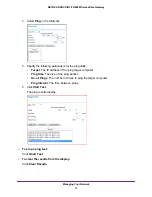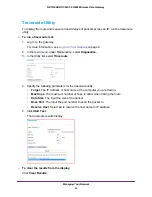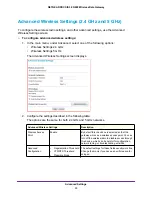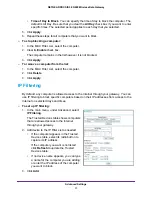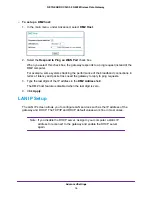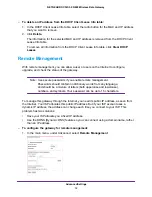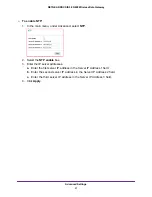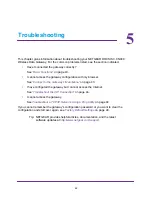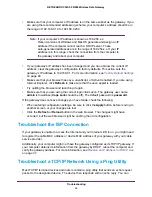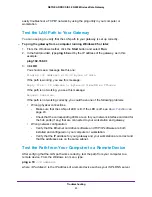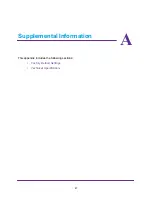
Advanced Settings
33
NETGEAR DOCSIS 3.0 N900 Wireless Data Gateway
•
Local IP Address
. Complete the local IP address for the computer that is using the
service.
4.
Perform one of the following actions:
•
Click
Add
to save your settings. The Active Filters table now displays the list of ports
that are currently blocked.
•
To delete a service, select the radio button in the Active Filters table for the service
that you want to delete, and click
Delete
.
•
To reset the selection in the Services drop-down list and to clear all the fields in the
Add Custom Service table, click
Reset
.
Port Forwarding
A firewall has default rules for inbound traffic (WAN to LAN) and for outbound traffic. Port
forwarding affects the inbound rules. These rules restrict access from outsiders. By default,
the gateway blocks access from outside except for responses to requests from the LAN side.
You can use port forwarding to add rules to specify exceptions to the default rule.
Because the gateway uses Network Address Translation (NAT), your network presents only
one IP address to the Internet, and outside users cannot directly address any of your local
computers. However, by defining an inbound rule you can make a local server (for example,
a web server or game server) or computer visible and available to the Internet. The rule tells
the gateway to direct inbound traffic for a particular service to one local server or computer
based on the destination port number. Directing traffic is also known as port forwarding.
Some residential broadband ISPs do not allow you to run server processes (such as a web or
FTP server) from your location. Your ISP might check for servers and suspend your account
if it finds active services at your location. See the ISP’s Acceptable Use policy.
Pay attention to the following considerations before configuring port forwarding:
•
If the DHCP assigns the IP address of the local server computer, the address might
change when the computer is rebooted. To keep the address from changing, you can
assign a static IP address to your server outside the range that DHCP assigns, but in the
same subnet as your LAN. By default, the IP addresses from 192.168.0.2 through
192.168.0.9 are reserved for this purpose.
•
Local computers must access the local server using the computers’ local LAN address
(192.168.0.XXX, by default). Attempts by local computers to access the server using the
external WAN IP address fail.
•
Port forwarding opens holes in your firewall. Enable only ports that are necessary.
To configure port forwarding and services for specific inbound traffic:
1.
In the main menu, under Advanced, select
Port Forwarding
.







